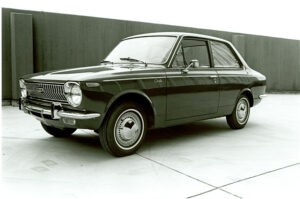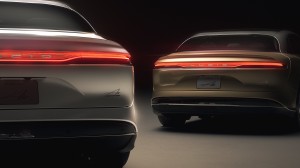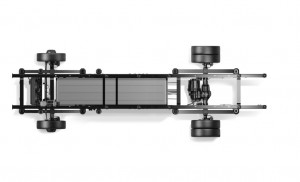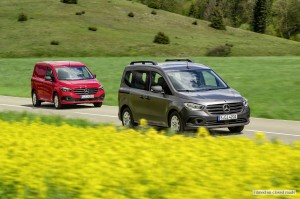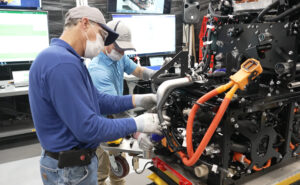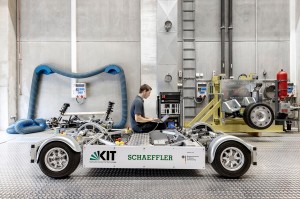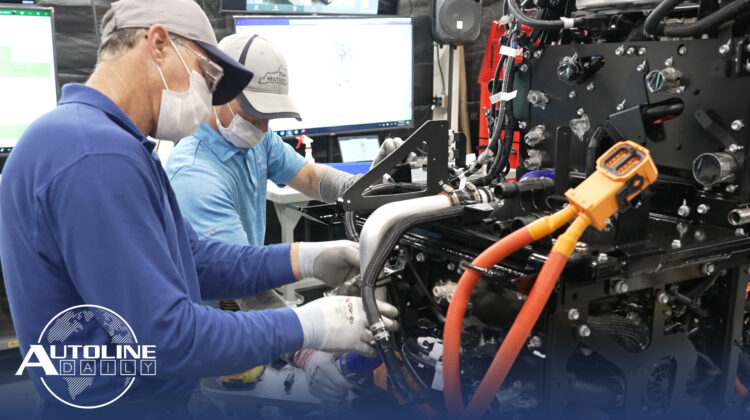
Listen to “AD #3148 – Audi Announces the End of ICEs; Bollinger Expanding Its Commercial Lineup; Toyota to Make Fuel Cell Kits” on Spreaker.
Follow us on social media:
Runtime: 11:10
0:07 Audi Announces the End of ICEs
0:27 Mercedes to Cut Its Engine Lineup in Half
0:54 Ford Delays Return to Office
1:23 How Issues Arose with Roofs for Ford’s Bronco
2:22 Toyota Corolla Reaches Sales Milestone
4:00 Lucid Ready to Launch Its Air Sedan
5:18 Bollinger Expanding Its Commercial Lineup
6:02 Mercedes Reveals New Citan Van
7:58 Toyota to Make Fuel Cells for Big Trucks
9:17 Schaeffler Teams with Universities to Develop Technology
Visit our sponsors to thank them for their support of Autoline Daily: BorgWarner, Bridgestone, Intrepid Control Systems, Schaeffler and Wacker.
This is Autoline Daily, the show dedicated to enthusiasts of the global automotive industry.
AUDI ANNOUNCES THE END OF ICEs
We’ve seen a number of automakers announce plans to go electric and now Audi is the latest. Starting in 2026, the automaker will only launch new vehicles with electric drive systems. And between now and 2033, it will phase out production of internal combustion engines completely.
MERCEDES TO CUT ITS ENGINE LINEUP IN HALF
Along the same lines, Mercedes is going to slash its diesel and gas engine lineup in Europe, so it can meet the region’s strict emission regulations. The company’s COO said that going through Euro 7 emission standards it will have to reduce the number of engine variants it has by 50%. It was not revealed what’s going away, but we’ve got to believe big, thirsty V8s will be some of the first.
FORD DELAYS RETURN TO OFFICE
Ford is once again delaying when salaried workers can come back to the office. The automaker told employees that they’ll continue to work remotely until at least January due to the resurgence of the coronavirus. It applies to workers in North America and most of its international operations. At the same time, Ford is also looking into hybrid models, where employees come to the office two or three days a week and work from home the rest of the time.
HOW ISSUES AROSE WITH ROOFS FOR FORD’S BRONCO
In other Ford news, WardsAuto is shedding some light on how issues arose with the hard-top for the Bronco. Hau Thai-Tang, Ford’s chief product platform and operations officer, says that Wabasto, the supplier that makes the roof, sourced tooling from another supplier that happens to be located in Wuhan, China. Due to the spread of the coronavirus there, the tooling was late in reaching Webasto. That was the root of the problem, but even after production began even a Ford spokesman admitted, “It just didn’t look right.” That along with rumored quality issues, Ford recalled the model it had already made and replaced the roofs for free. But even as it gets the problem under control, there could still be problems meeting demand. There’s whispers that Ford and Webasto were surprised by the number of hand raisers for the hardtop and now realize Webasto’s plant that makes the roof is not big enough.
TOYOTA COROLLA REACHES SALES MILESTONE
Man, talk about brand equity. Toyota started making the Corolla 55 years ago, it’s gone through 12 different generations, and last month it passed the 50 million mark in sales. The Corolla hit the market in Japan in 1966. It came to the U.S. market in 1969 with a base price of $1,700, which in today’s money would be about $12,600. Today’s Corolla starts at $20,000. So why is it so much more expensive? Because it delivers far higher levels of safety, much lower levels of emissions, and significantly better fuel economy–not to mention that it’s quieter, smoother, more powerful and just better all around. And making it that much better doesn’t come for free.
LUCID READY TO LAUNCH ITS AIR SEDAN
With its SPAC merger and listing on Wall Street behind it, Lucid is ready to start delivering its Air sedan to customers. The first examples will be the $169,000 Dream Edition and it just announced that reservation holders will have the choice between two versions; one geared toward performance and the other for range. The Performance has a dual motor, all-wheel drive setup that puts out 1,111 horsepower and does 0-60 in under 2.5 seconds. The Dream Edition Range is also a dual motor, all-wheel drive setup, but it puts out 933 horsepower and will do 0-60 in 2.7 seconds. While Lucid is still waiting for EPA figures, it did do a range test with Motor Trend using two Range cars on a highway in California. They completed the 445 mile trip on a single charge and one had 30 miles of charge remaining while the other had 72 miles. EPA figures will not be that high, but it’s still pretty impressive. Deliveries of both versions will start before the end of the year and Lucid will launch the Air Grand Touring shortly after.
BOLLINGER EXPANDING IT CV LINEUP
EV startup Bollinger Motors is expanding its commercial vehicle lineup. The company will offer Class 4 and Class 5 commercial trucks in addition to the Class 3 vehicles it announced last year. The Class 4 truck has a weight rating of 16,000 pounds, a payload of 9,000 pounds with 1,000 cubic feet of cargo space, while the Class 5 truck has a weight rating of 19,500 pounds, a payload of 11,000 pounds and 1,200 cubic feet of cargo space. Both models will have ranges over 200 miles. Bollinger plans to build prototypes soon and production could start in 2023.
MERCEDES REVEALS NEW CITAN VAN
Speaking of commercial vehicles, Mercedes revealed the new Citan van. It’s offered as both a Panel van and Tourer. The Tourer comes with a rear bench seat. The first examples to hit the market will have a short wheel base, but a long wheelbase model will also be available. But even with the short wheelbase Mercedes says it has more cargo space than the previous model. The new Citan will have the option of 3 diesel engines and two gasoline, which can be mated to either a 6-speed manual or 7-speed DCT. But this will also be the last new vehicle project for commercial customers from Mercedes-Benz Vans that uses an ICE. The eCitan is scheduled to launch in the second half of 2022 with the same cargo space as the ICE versions and an estimated range of 285 kilometers or 177 miles. The other versions will launch in the middle of next month in Europe and carry a starting price of 23,800 euros in Germany.
TOYOTA TO MAKE FUEL CELLS FOR BIG TRUCKS
Slowly but surely fuel cells vehicles continue to inch their way forward. In a surprise development ,Toyota announced it’s going to start manufacturing fuel cells for heavy trucks at one of its assembly plants in Georgetown, Kentucky in 2023. Remember, that’s when Toyota said it’s going to axe the Avalon, which is built at the same plant. Even more surprising is that Toyota wants to sell them to Class-8 manufacturers. It’s highly unlikely that Toyota would make this kind of investment unless it already had a commitment from a truck manufacturer to buy them. Toyota will sell a kit that includes the fuel cell stack, a high voltage battery, electric motors, the transmission and hydrogen storage assembly. It will deliver 300 miles of range in a Class-8 semi with an 80,000 pound cargo load. Here’s our Autoline Insight. Toyota’s development vehicles are Kenworths, so we’re guessing that’s who’s going to buy these fuel cells. Kenworth is owned by PACCAR, which also makes Peterbilt. And PACCAR is the last American-owned heavy truck manufacturer. If it buys fuel cells from Toyota it will instantly be competitive in the race for zero emission Class-8 semis.
SCHAEFFLER TEAMS WITH UNIVERSITIES TO DEVELOP TECHNOLOGY
Automakers and suppliers are always on the lookout for universities they can team up with to develop new technology. The supplier Schaeffler has a program called SHARE, or Schaeffler Advanced Research that includes two universities in Germany, one in Singapore, and one in China. And now it’s adding Ohio State University–oops, apologies to all the Buckeye fans out there. I meant to say THE Ohio State University. Schaeffler is relying on these universities to help it develop automated mobility, hydrogen technologies and renewable energies, digitalization, robotics, and Industry 4.0. Why recruit these schools? Because students often approach problems with a fresh set of eyes. They don’t bring a lot of baggage in terms of conventional thinking. And while that doesn’t always work out, it can lead to big breakthroughs.
We invite you to join us for Autoline After Hours this afternoon at 3 pm eastern time. Some of the topics that John and Gary will get into include What Effect, if any, Will the Bolt Battery Debacle Have on Future EV Sales? Is the End of Prop 22 the End of Uber in California? And it takes 26 Weeks to make a chip. Will the car companies ever catch up?
But that’s a wrap for today. Thanks for tuning in.
Thanks to our partner for embedding Autoline Daily on its website: WardsAuto.com
Seamus and Sean McElroy cover the latest news in the automotive industry for Autoline Daily.




